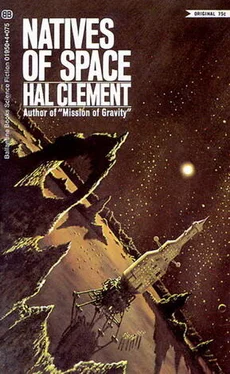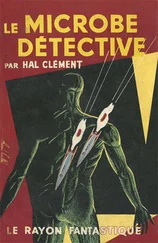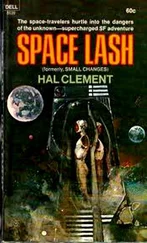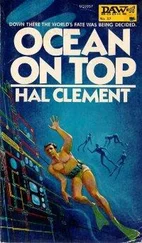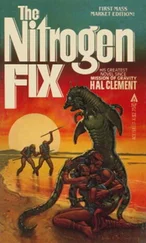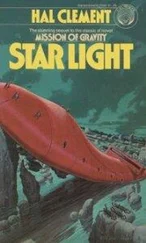Hal Clement - Natives of Space
Здесь есть возможность читать онлайн «Hal Clement - Natives of Space» весь текст электронной книги совершенно бесплатно (целиком полную версию без сокращений). В некоторых случаях можно слушать аудио, скачать через торрент в формате fb2 и присутствует краткое содержание. Город: New York, Год выпуска: 1965, Издательство: Ballantine Books, Жанр: Фантастика и фэнтези, на английском языке. Описание произведения, (предисловие) а так же отзывы посетителей доступны на портале библиотеки ЛибКат.
- Название:Natives of Space
- Автор:
- Издательство:Ballantine Books
- Жанр:
- Год:1965
- Город:New York
- ISBN:нет данных
- Рейтинг книги:5 / 5. Голосов: 1
-
Избранное:Добавить в избранное
- Отзывы:
-
Ваша оценка:
- 100
- 1
- 2
- 3
- 4
- 5
Natives of Space: краткое содержание, описание и аннотация
Предлагаем к чтению аннотацию, описание, краткое содержание или предисловие (зависит от того, что написал сам автор книги «Natives of Space»). Если вы не нашли необходимую информацию о книге — напишите в комментариях, мы постараемся отыскать её.
Natives of Space — читать онлайн бесплатно полную книгу (весь текст) целиком
Ниже представлен текст книги, разбитый по страницам. Система сохранения места последней прочитанной страницы, позволяет с удобством читать онлайн бесплатно книгу «Natives of Space», без необходимости каждый раз заново искать на чём Вы остановились. Поставьте закладку, и сможете в любой момент перейти на страницу, на которой закончили чтение.
Интервал:
Закладка:
The chemist, who should have known more physics, nodded. “But it’s more than the lubricant that keeps the parts of an engine apart,” he said.
“No, the parts of one of our machines are relatively far apart, so that molecular attraction is negligible,” answered the machinist. “But — I believe you have something there. A lubricant might do it; molecules might conceivably work their way between those surfaces. Has anybody noticed anything in this mess that might fill the bill?”
“Yes,” answered Preble promptly, “these glass tubes. They contain liquid, and have been fused shut — which is about the only way you could seal in a substance such as you would need.”
He stepped to a cabinet and picked up one of the three-inch long, transparent cylinders. A short nozzle, its end melted shut, projected from one end, and a small bubble was visible in the liquid within. The bubble moved sluggishly when the tube was inverted, and broke up into many small ones when it was shaken. These recombined instantly when the liquid came to rest, which was encouraging. Evidently the stuff possessed a very low viscosity and surface tension.
Cray took the tube over to the breech which had been partly opened and carelessly closed so long ago, held the nozzle against the edge of the seal, and, after a moment’s hesitation, snapped off the tip with his gloved fingers. He expected the liquid to ooze out in the asteriod’s feeble gravity, but its vapor pressure must have been high, for it sprayed out in a heavy stream. Droplets rebounded from the metal and evaporated almost instantly; with equal speed the liquid which spread over the surface vanished. Only a tiny fraction of a percent, if that, could have found its way between the surfaces.
Cray stared tensely at the dome of metal as the tube emptied itself. After a moment, he dropped the empty cylinder and applied a sideways pressure.
A crescent, of shifting rainbow colors, appeared at the edge of the seal; and the dome slowly slid off to one side. The crescent did not widen, for the lubricant evaporated the instant it was exposed. Preble and Stevenson caught the heavy dome and eased its mass to the central catwalk.
The last of the rainbow film of lubricant evaporated from the metal, and the engineers crowded around the open breech. There was no mass of machinery inside; the disintegrators would, of course, be within the dome which had been removed. The coils which generated the fields designed to keep the stream of ionized vapor from contact with the tube walls were also invisible, being sealed into the tube lining. Neither of these facts bothered the men, for their own engines had been similarly designed. Cray wormed his way down the full length of thetube to make sure it was not field failure which had caused it to be opened in the first place; then the three specialists turned to the breech which had been removed.
The only visible feature of its flat side was the central port through which the metallic vapor of the exhaust had entered the tube; but application of another of the cylinders of lubricant, combined with the asteroid’s gravity, caused most of the plate to fall away and reveal the disintegrator mechanism within. Preble, Stevenson, Grant, and McEachern watched for a while as pieces of the disintegrator began to cover the floor of the room; but they finally realized that they were only getting in the way of men who seemed to know what they were doing, so a gradual retreat to the main corridor took place.
“Do you suppose they can find out what was wrong with it?” queried Stevenson.
“We should.” It was Cray’s voice on the radio. “The principle of this gadget is exactly like our own. The only trouble is that they’ve used that blasted molecular-attraction fastening method everywhere. It’s taking quite a while to get it apart.”
“It’s odd that the technology of these beings should have been so similar to ours in principle, and yet so different in detail,” remarked Grant. “I’ve been thinking it over, and can’t come to any conclusion as to what the reason could be. I thought perhaps their sense organs were different from ours, but I have no idea how that could produce such results — not surprising, since I can’t imagine what sort of senses could exist to replace or supplement ours.”
“Unless there are bodies in the sealed-off corridor and rooms, I doubt if you’ll ever find the answer to that one,” answered Preble. “1’ll be greatly surprised if anyone ever proves that this ship was made in this solar system.”
“I’ll be surprised enough if anyone proves anything at all constructive about it,” returned Grant.
Cray’s voice interrupted again.
“There’s something funny about part of this,” he said. “I think it’s a relay, working from your main controls, but that’s only a guess. It’s not only connected to the electric part of the business, but practically built around the fuel inlet as well. By itself it’s all right; solenoid and moving core type. We’ve had it apart, too.”
“What do you plan to do?” asked Grant. “Have you found anything wrong with the unit as a whole?”
“No, we haven’t. It has occurred to me that the breech was unsealed for some purpose other than repair. It would make a handy emergency exit — and that might account for the careless way it was resealed. We were thinking of putting it back together, arranging the relay so that we can control it from here and test the whole tube. Is that all right with you?”
“If you think you can do it, go ahead,” replied Grant. “We haven’t got much to lose, I should say.
Could you fix up the whole thing to drive by local control?”
“Possibly. Wait till we see what happens to this one.” Cray moved out of the line of sight in the engine-room doorway, and his radio waves were cut off.
Stevenson moved to the doorway to watch the process of reassembly; the other three went up to the control room. The eeriness of the place had worn off — there was no longer the suggestion of the presence of the unknowable creature who had once controlled the ship. Preble was slightly surprised, since it was now night on this part of the asteroid; any ghostly suggestions should have been enhanced rather than lessened. Familiarity must have bred contempt.
No indicator lights graced the control panel. Grant had half hoped that the work in the engine room might have been recorded here; but he was not particularly surprised.
He had given up any hopes of controlling the vessel fron this board, as his remark to Cray had indicated.
“I hope Cray can get those tubes going,” he said after a lengthy silence. “It would be enough if we could pus’ this ship even in the general direction of Earth. LucldI3 the orbit of this body is already pretty eccentric. About all we would have to do is correct the plane of motion.”
“Even if we can’t start enough tubes to control a flight, we could use one as a signal flare,” remarked Preble, “Remember, the Mizar is in this sector; you once had hopes of contacting her with the signal equipment of this ship, if you could find any. The blast from one of these tubes, striking a rock surface, would make as much light as you could want.”
“That’s a thought,” mused Grant. “As usual, too simple for me to think of. As a matter of fact, it probably represents our best chance. We’ll go down now and tell Cray simply to leave the tube going, if he can get it started.”
The four men glided back down the corridor to the engine room. The reassembly of the breech mechanism was far from completed, and Grant did not like to interrupt. He was, of course, reasonably familiar with such motors, and knew that their assembly was a delicate task even for an expert.
Cray’s makeshift magnetic device for controlling the relay when the breech was sealed was a comment on the man’s ingenuity. It was not his fault that none of the men noticed that the core of the relay was made of the same alloy as the great screw cocks which held the engine-room doors shut, and the small bolts on the doors in the cargo hold. It was, in fact, a delicate governor, controlling the relation between fuel flow and the breech field strength — a very necessary control, since the field had to be strong enough to keep the hot vapor from actual contact with the breech, but not strong enough to overcome the effect of the fields protecting the throat of the tube, which were at right angles to it. There was, of course, a similar governor in man-made motors, but it was normally located in the throat of the tube and was controlled by the magnetic effect of the ion steam. The device was not obvious, and of course was not of a nature which a human engineer would anticipate. It might have gone on operating normally for an indefinite period, if Cray had used any means whatever, except magnetic manipulation, to open and close the relay.
Читать дальшеИнтервал:
Закладка:
Похожие книги на «Natives of Space»
Представляем Вашему вниманию похожие книги на «Natives of Space» списком для выбора. Мы отобрали схожую по названию и смыслу литературу в надежде предоставить читателям больше вариантов отыскать новые, интересные, ещё непрочитанные произведения.
Обсуждение, отзывы о книге «Natives of Space» и просто собственные мнения читателей. Оставьте ваши комментарии, напишите, что Вы думаете о произведении, его смысле или главных героях. Укажите что конкретно понравилось, а что нет, и почему Вы так считаете.
